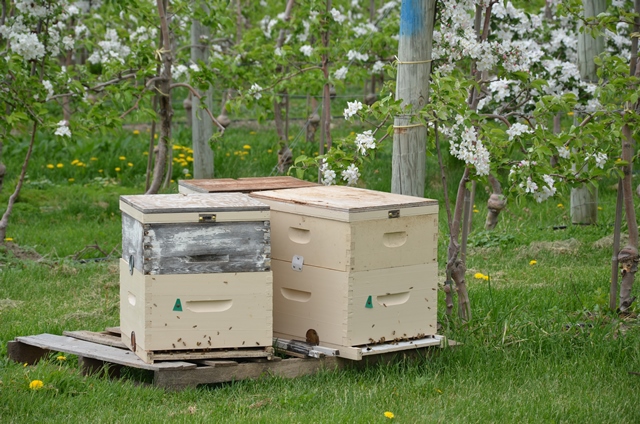
The Blossoms and the Bees
May 01, 2015
Spring is one of the most beautiful times of the year in an apple orchard. Trees filled with fragrant, picturesque blossoms bring the promise of a new season and a new crop of apples.
But how do we get from little white flowers in spring to tasty fresh apples in the fall? That’s all due to honey bees and a process called pollination.
As the bees move from blossom to blossom gathering nectar, they are also moving pollen from the male parts to the female parts of the flowers, which is what then causes a small apple to grow.
Most apple growers work directly with a beekeeper to have hives brought into the orchards as the trees start to bloom in the spring and many have been working with the same beekeeper for many years.

Apple growers who also have pear, cherry or other fruit trees on their farms will keep the bee hives in their orchards until all the different trees have blossomed and been pollinated by the bees.
“One day in full bloom in good weather can be all it takes in apples to pollinate an orchard,” explains beekeeper Brian Rowaan of Niagara-on-the-Lake, who has been working with bees since his youth and now manages thousands of hives. “If the weather is hot, the bloom will be over faster. It also depends on the varieties as some will be in bloom longer than others.”
Apple growers on average will have a beekeeper place one to three hives per acre in an orchard, with approximately 50,000 bees in each hive, although this will depend on the age of their orchard – younger trees have fewer blossoms – and how much damage their trees might have suffered over the winter months.
A beekeeper will generally take hives to just one apple orchard a year in a certain part of Ontario as all the trees will generally bloom at the same time. It is possible however, explains Rowaan, to put hives into an orchard in southern Ontario first and then move them into an apple orchard in the Georgian Bay area, where the trees will generally blossom a bit later due to the slightly cooler climate.
Although Rowaan’s European honey bees make the trek to the Maritimes for blueberry pollination once apple blossom season is over in Ontario, the majority of beekeepers will switch their focus from pollination to honey production.
“Apple pollination usually finishes in mid- to late-May, so that’s when the honey starts flowing in Ontario,” he says.
To get their bees through the cold winter months, beekeepers wrap their hives with insulation for protection and make sure they have enough food and are placed in a sheltered location out of the wind.
“Bees do fairly well in the cold as long as they have good conditions. We feed them to make sure they have enough food and the hive needs to be well ventilated so it doesn’t produce condensation,” Rowaan explains, adding the bees’ behaviour is similar to that of hibernating mammals. “For the most part, they just hunker down, cluster and do very little in the winter.”
